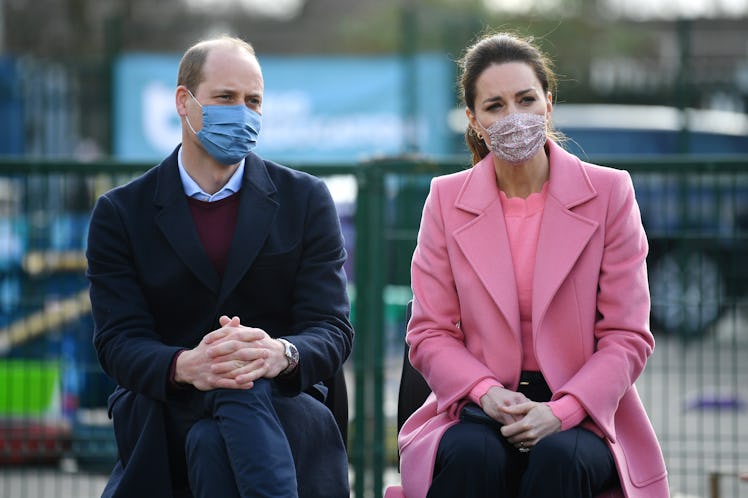
A Body Language Expert Claims Kate Is Hiding How She Really Feels RN
Yikes. In their very first public appearance since the bombshell Oprah Winfrey interview, Prince William and Kate Middleton's body language is tense. The appearance in question took place on March 17, when the couple made a cameo in a St. Patrick's Day video featuring leaders from across the world. On the surface, the short clip featuring the Duke and Duchess of Cambridge seemed fun and even flirty.
But upon further investigation, Patti Wood, a body language expert and author of Snap: Making the Most of First Impressions, Body Language, and Charisma says there might be more to the story.
For William, the appearance seemed to be nothing but business as usual. "He had his arms behind his back," Wood points out. "He typically [does this] when he's out in public." While his posture was pretty formal, he did give away a hint of emotion by rising up on his toes multiple times. According to Wood, this means he "really cared about" the event ... [there's] a desire to be on his toes, do well, and to perform well." His expressions "were warm, fairly open, and playful." She adds, "That was not acting."
If he's feeling down about the current distance between him and his brother, he didn't show it.
Kate's body language is a little more complicated. Wood notes, “One side of the mouth is up and one side of the mouth is more down, and that lack of symmetry in the smile indicates that something is hidden." She makes that face multiple times throughout the video. According to Wood, an asymmetrical smile can happen when a person is trying to hide how they really feel. The limbic system, the emotional part of the brain, signals true feelings to their face, while the neocortex, the logical part of the brain, attempts to hide the raw emotion from showing.
According to Wood, if a person constantly attempts to mask their true feelings, that asymmetrical expression will show more and more often over time. For Kate, the expression seems to be a new development. “I've been reading her body language for a long time,” says Wood. “It wasn't like that originally. It wasn't like that when she got married."
During Prince Harry and Meghan Markle's tell-all interview with Oprah Winfrey on March 7, the couple revealed some of the hardships they experienced as members of royal of the family. They claimed an unnamed member of the royal family had "concerns" over how dark their son Archie's skin would be. (Since then, William has told reporters, "We’re very much not a racist family.") Meghan also revealed the intense toll royal life had on her mental health. (Content warning: This story discusses suicidal ideation.) As a result of the pressures of royal life and scrutiny by the British tabloids and social media, she experienced suicidal ideation. In fact, Meghan even revealed there are several happy-looking photos of her that were taken just shortly after she told Harry she was contemplating suicide.
At another point in the interview, Meghan addressed the headlines that alleged she made Kate cry in an argument prior to her and Harry's wedding in 2018. "The narrative with Kate, which didn’t happen, was really difficult," Meghan told Oprah. She claimed the press actually got the story wrong — Kate made her cry.
Meghan was careful to note that Kate is a "good person" and that she apologized and sent her flowers after the incident. She urged royal fans to not pit the two women against each other. “If you love me, you don’t have to hate her," she said. "And if you love her, you don’t have to hate me.”
It sounds as if the royal family has a lot of healing to do. Hopefully, each member of the family will be able to move forward, prioritizing their health and happiness.
This article was originally published on